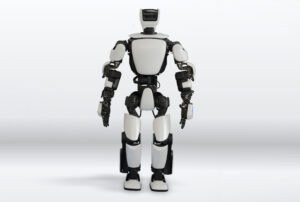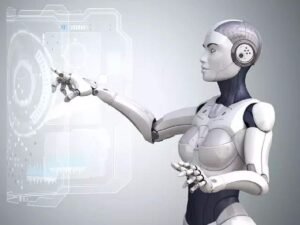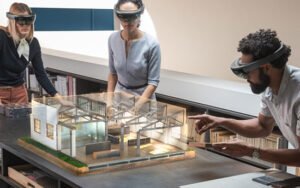
If you’ve ever asked the question, “What’s next for the retail industry?” then this roundup is for you. This report sheds light on the trends and issues that we think will make the biggest impact on the retail industry in the very near future.
Let’s dive in.
- Humanoid Robot:
A humanoid robot is a robot with its body shape built to resemble the human body. The design may be for functional purposes, such as interacting with human tools and environments, for experimental purposes, such as the study of al locomotion, or for other purposes. In general, humanoid robots have a torso, a head, two arms, and two legs, though some forms of humanoid robots may model only part of the body, for example, from the waist up. Some humanoid robots also have heads designed to replicate human facial features such as eyes and mouths. Androids are humanoid robots built to aesthetically resemble humans.
Humanoid robots are now used as research tools in several scientific areas.
Researchers study the human body structure and behavior (biomechanics) to build humanoid robots. On the other side, the attempt to simulate the human body leads to a better understanding of it. Human cognition is a field of study which is focused on how humans learn from sensory information in order to acquire perceptual and motor skills. This knowledge is used to develop computational models of human behavior and it has been improving over time.
- Self Check out
Self-scanning checkout, also called “self-checkout” is an automated process that enables shoppers to scan, bag, and pay for their purchases without human assistance. Typically, a self-scanning checkout lane looks very much like a traditional checkout lane except that the shopper interacts with a computer’s user interface (UI) instead of with a store employee.The shopper begins the checkout process by touching the computer’s welcome screen or, with some systems, by simply beginning to scan items. Once the checkout has been initiated by the shopper, the computer’s animated voice provides the shopper with step-by-step instructions about how to scan their items and where to place them once they’ve been scanned.
When the shopper scans an item, the item’s barcode provides the computer with the information it needs to determine what item is being scanned, as well as the item’s weight and current price. If the store uses security tags, the system can also deactivate them during the scanning process. If the security tag is not deactivated, an alarm system sounds when the shopper leaves the store.

- Pay Pod
Paypod is the latest point-of-sale automated payment innovation. It’s designed with everything you need as an independent retailer. Not only can you enjoy more time servicing your customers, it can be installed same-day in under an hour so there’s no impact on your business.
Paypod combines three highly-engineered technologies into one easy-to-install system that delivers the ultimate ease in payment automation. A single unit houses a coin recycler and a note recycler that interface with POSlinqTM software to instantaneously connect with any Windows® point-of-sale system. Designed to meet retailers’ unique business needs, Paypod comes in two distinct models that offer flexibility and modularity to our customers. The result is a payment solution that contains everything you need for same-day installation, and backed by the security and support of UNLTD Devices W.L.L.
- Artificial intelligence
Back in 2016, Gartner predicted that by 2020, 85 percent of customer interactions would be managed without human involvement. In 2018 we will see AI adoption continue to rise with chatbots taking the lead. Due to increasing ease of deployment, instant availability and improved quality, chatbots will become more and more common to manage customer service queries and to make intelligent purchase recommendations. We will also see the rise of AIpowered conversational interfaces and voice assistants. Retailers can engage this kind of technology to answer routine questions and supplement human customer support with chat-based shopping or voice commerce. Alongside having the technology available, retailers now also have a significant amount of data to power AI and deliver personalized, customized and localized experiences to customers. AI will be applied across the entire retail product and service cycle, from manufacturing to post-sale customer service interactions. Retailers using AI to its fullest potential will be able to influence purchases in the moment and anticipate future purchases, guiding shoppers towards the right products in a regular and highly personalized manner. In order to maximize the impact of AI, in 2018 we will see new partnerships and collaborations between retailers and technology companies emerge. Retailers recognize that building or buying the technology they need isn’t the best use of their resources. Instead, we will see a rise retailers partnering with niche technology players – collaboration will be the key to success.



0 Comments